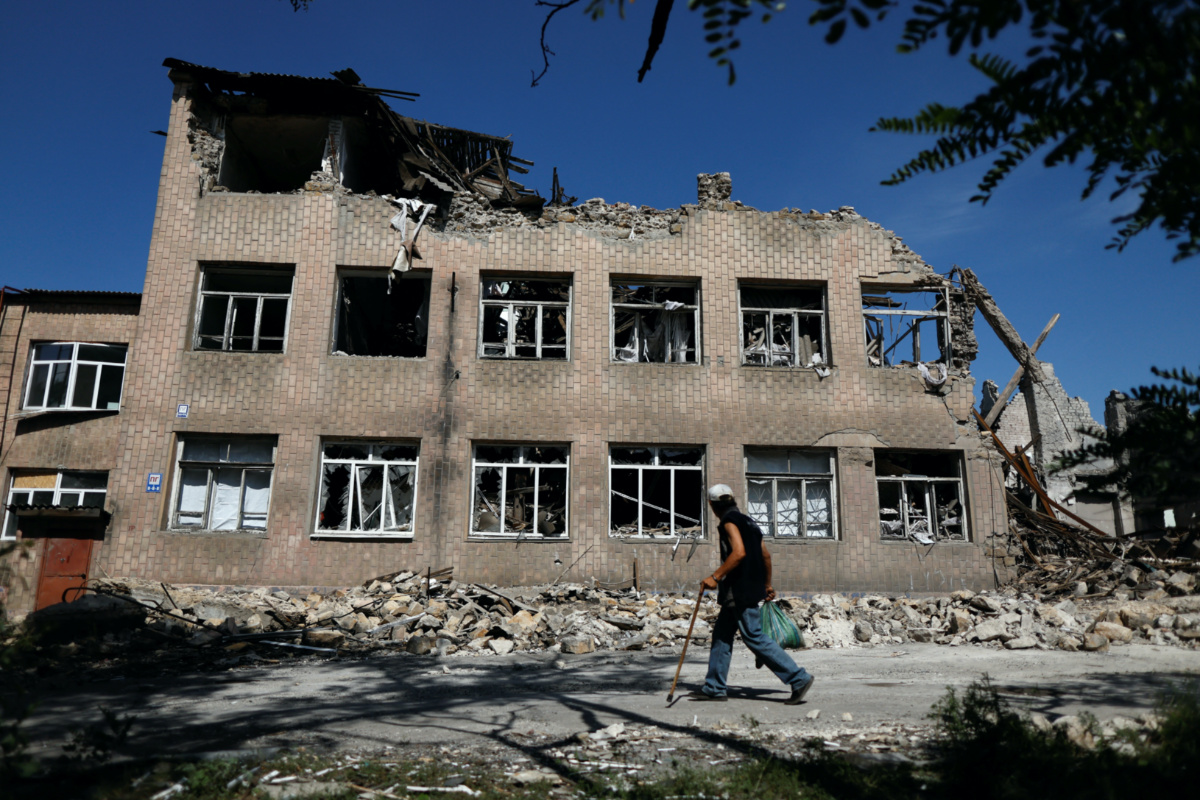
Reuters looks at key moments during six months of conflict in Ukraine…
Six months ago this week, Vladimir Putin ordered tens of thousands of Russian troops into Ukraine on a “special military operation” – a mass invasion on a scale unseen in Europe since World War II.
Since then, tens of thousands of people have been killed, millions have fled and cities have been reduced to rubble by Russia’s relentless bombardment.

A man walks near a destroyed school, as Russia’s attack on Ukraine continues, in Toretsk, Donetsk region, Ukraine, on 22nd August. PICTURE: Reuters/Ammar Awad.
Here are some milestones from the conflict:
A chilling speech
Russia repeatedly denied it would invade Ukraine and once it did, said it sought to “disarm” Kyiv, purge it of “nationalists” and halt the expansion of NATO, not seize territory. But Ukrainians say an address by Russian President Vladimir Putin three days before the 24th February invasion left no doubt he aimed to conquer their country and wipe out their 1,000-year national identity.
“Ukraine is not just a neighbouring country for us. It is an inalienable part of our own history, culture and spiritual space,” Putin said. “Since time immemorial, the people living in the southwest of what has historically been Russian land have called themselves Russians and Orthodox Christians.”
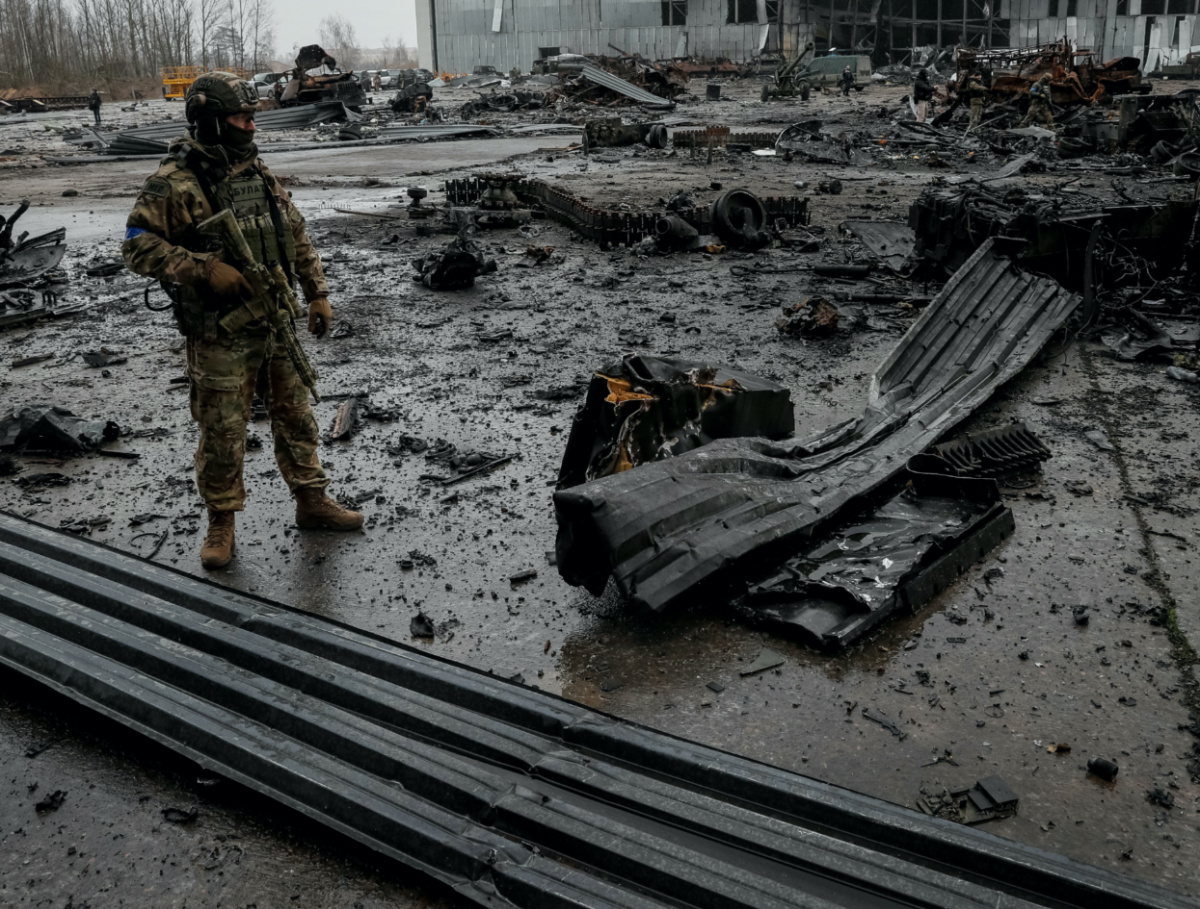
A Ukrainian service member inspects a compound of the Antonov airfield, as Russia’s attack on Ukraine continues, in the settlement of Hostomel, in Kyiv region, Ukraine, on 3rd April. PICTURE: Reuters/Gleb Garanich/File photo.
An early defeat
Within hours of the invasion, Russia landed commandos at Antonov airfield, a cargo base just north of Kyiv, to secure an air bridge for a lightning assault on the capital.
Within a day, Ukrainians had wiped out the elite Russian paratroops and destroyed the landing strip. While Russia’s armoured columns would eventually reach the northern outskirts of Kyiv, the failure to secure a working air field on day one helped wreck Moscow’s plan to swiftly seize the capital.
“I’m here”
As Russian bombs fell on Kyiv and its residents huddled in metro stations for shelter or crammed train stations to flee, President Volodymyr Zelenskiy made clear he would go nowhere.
“Good morning Ukrainians,” the former sitcom actor said, with the hint of a smile, in a mobile phone selfie video taken in the early light of the war’s third morning. Behind him was a landmark building in central Kyiv. “Ya tut.” I’m here.
Zelenskiy went on to rally his country in nightly addresses, his combat fatigues, sparse stubble and casual but firm speaking style becoming symbols of Ukraine’s resistance.
Since then, he has used video links to invoke Martin Luther King to the US Congress and the Berlin Wall to the Bundestag. He has been beamed into the streets of Prague, the Grammy awards and the Glastonbury music festival, where he told cheering fans to “prove that freedom always wins”.
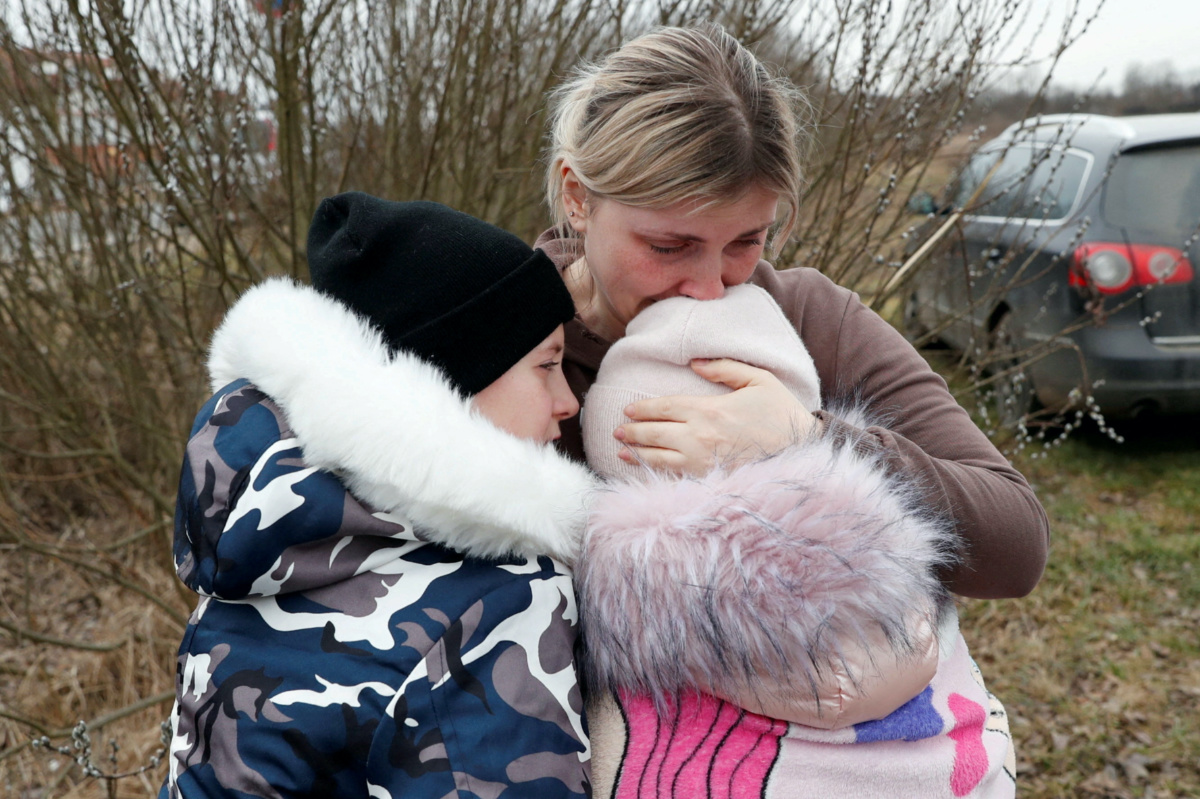
Anna Semyuk, 33, hugs her children at the Beregsurany border crossing, Hungary, on 26th February. The children were handed at the Ukrainian side of the border by the father, who is not allowed to cross, to Nataliya Ableyeva, 58, a stranger to the family who took the children across the border and kept them safe. PICTURE: Reuters/Bernadett Szabo/File photo.
Carrying a stranger’s children
As Russia pounded Ukrainian cities, millions took flight in what the United Nations said was the fastest-growing refugee crisis in generations. More than 6.6 million refugees have been recorded across Europe, most in neighbouring countries, which opened their arms. Kyiv banned men of fighting age from leaving.
“Their father simply handed over the two kids to me, and trusted me, giving me their passports to bring them over,” Natalya Ableyeva, 58, said on the border with Hungary two days after the invasion, the arms of the young boy she had known for just a few hours around her neck.
On the Hungarian side of the border, the children were later reunited with their mother, who wept as she hugged them tightly.
We rely on our readers to fund Sight's work - become a financial supporter today!
For more information, head to our Subscriber's page.
Glimpses of hell
Mariupol, a once-prosperous southern port, was destroyed by Russian forces over three months of what the Red Cross called “hell”. Ukraine says tens of thousands of civilians died, with food, water and medical supplies cut and continuous bombing trapping many in basements. The United Nations says the toll is unknown.
On 9th March, Russia bombed a Mariupol maternity hospital, killing three people, including a child. The Organization for Security and Cooperation in Europe called it a war crime. Moscow said the building was disused and occupied by fighters.
A week later, a theatre where Ukraine said families were sheltering in the basement was destroyed. The word “children” could be seen in satellite photos painted on the ground outside. Kyiv says Russia bombed it deliberately to break the city’s will and that hundreds of bodies are still believed buried; Russia said, without giving any evidence, that the incident was staged.
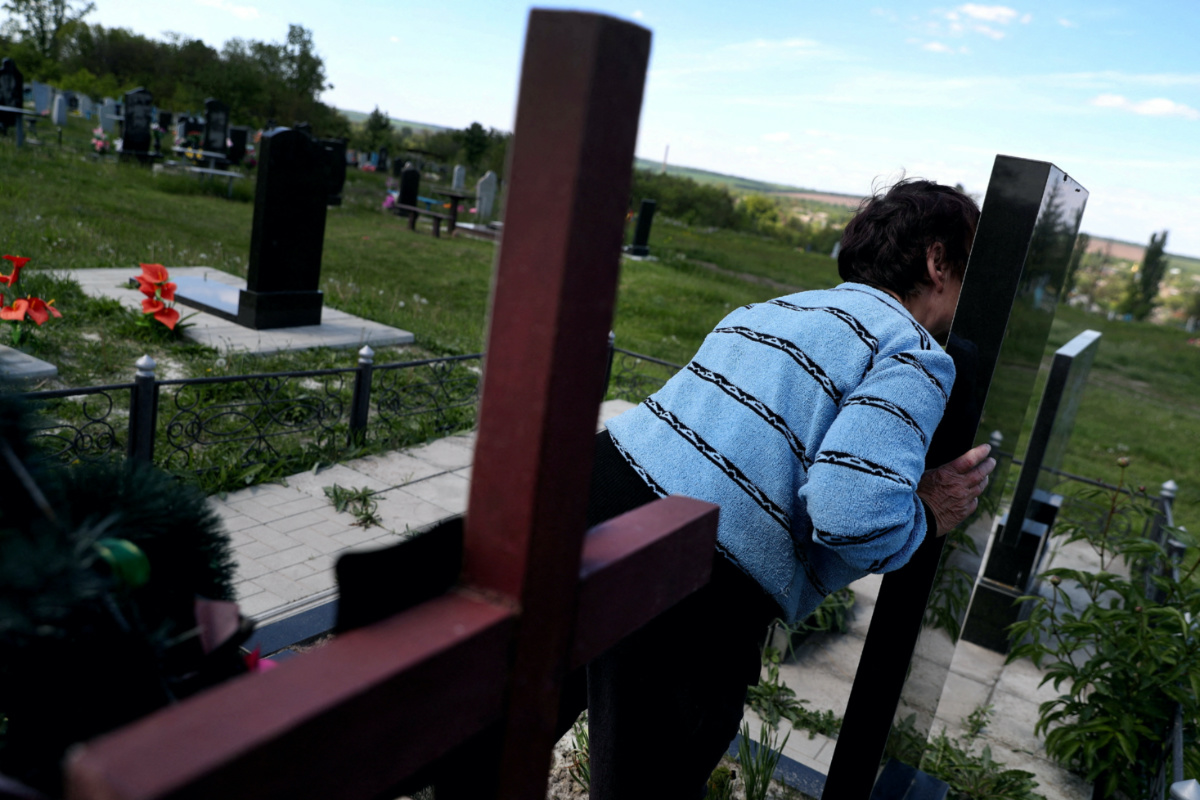
Kateryna Shelikhova, widow of 62-year-old Oleksandr Shelipov, who was shot dead by a Russian soldier who was sentenced to life in prison for killing an unarmed civilian in the first war crimes trial arising from Russia’s invasion, kisses the grave of her daughter at the local cemetery while visiting her husband’s grave, as Russia’s attack on Ukraine continues, in Chupakhivka, Ukraine, on 24th May. PICTURE: Reuters/Ivan Alvarado
Bodies in streets
By the end of March, Russia’s assault on Kyiv had failed. Its armoured columns, vulnerable to mobile units of Ukrainian defenders with anti-tank missiles and drones, had become bogged down and sustained heavy losses. Moscow announced its withdrawal from northern Ukraine as a “goodwill gesture”. But as its troops pulled out, they left evidence of their occupation in ruined towns and villages where bodies lay in the streets.
Scores of victims were found in the once prosperous suburb of Bucha, some with hands tied. Russia denied blame and claimed, with no evidence, that the killings were staged.
“Russian warship…”
In the first hours of the invasion, Russian officers on the Black Sea Fleet flagship Moskva radioed Ukrainian guards on the barren but strategic Black Sea outcrop Snake Island, ordering them to surrender or die. One of them radioed back “Russian warship, go f*** yourself.”
The phrase became a national slogan, depicted on Ukrainian billboards, T-shirts, and eventually a postage stamp showing a Ukrainian guard standing on the outcrop, giving the flagship the finger.
The day the stamp was released, 14th April, two Ukrainian missiles struck the Moskva, the biggest warship sunk in combat for 40 years. Officially, Russia says one sailor was killed in an accident. Western experts say they believe around half of the crew of about 450 perished at sea.
On 30th June, Russia abandoned Snake Island after taking heavy losses trying to defend it. It called its withdrawal another “goodwill gesture”.
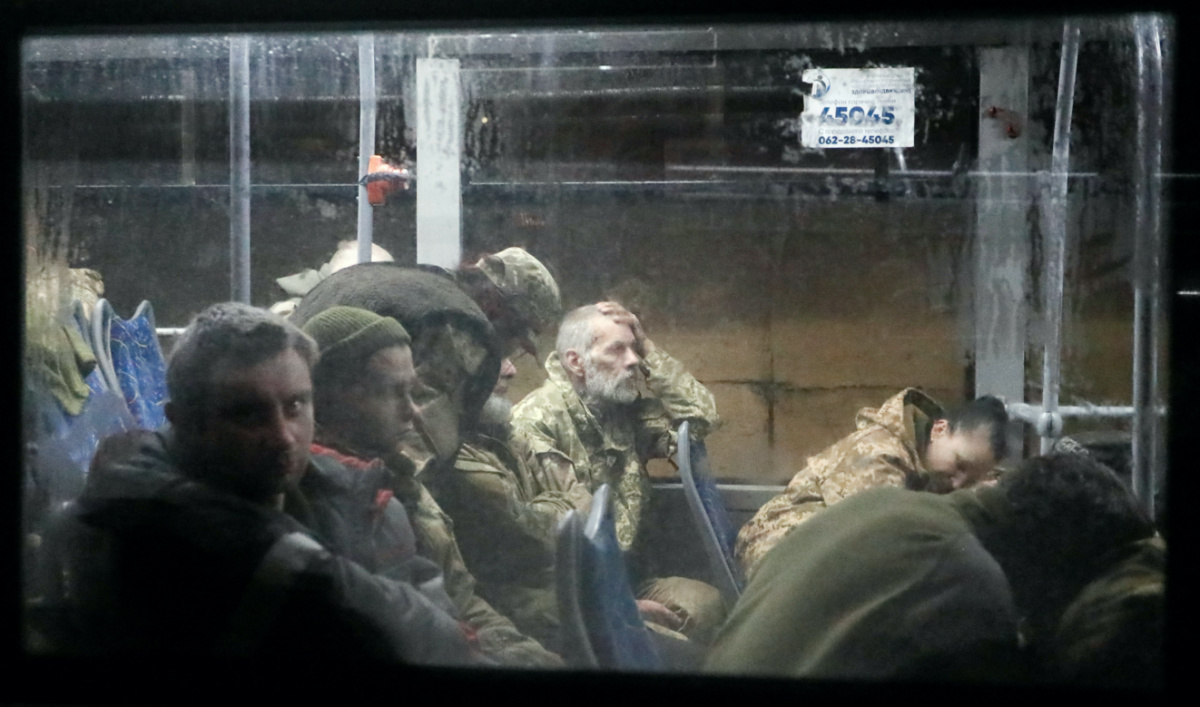
Service members of the Ukrainian armed forces, who surrendered at the besieged Azovstal steel mill in Mariupol in the course ofUkraine-Russia conflict, sit in a bus upon their arrival under escort of the pro-Russian military in the settlement of Olenivka in the Donetsk region, Ukraine, on 20th May. PICTURE: Reuters/Alexander Ermochenko/File photo.
Azovstal
The siege of Mariupol wore on, largely beyond the world’s gaze. Reuters reporters who reached the city from the Russian-held side found an eery, silent wasteland, where bewildered civilians emerged from cellars beneath the ruins to bury their dead in grass by the roadside.
The last Ukrainian troops were holed up in Azovstal, one of Europe’s largest steel plants, where underground tunnels served as bunkers. On 16th May, Ukraine’s general staff told them to surrender to save their lives. Reuters journalists saw them emerging, carrying their wounded on stretchers to buses that took them to a prison camp run by pro-Russian separatists.
Moscow pledged to treat the Azovstal prisoners according to the Geneva conventions but rebuffed Ukrainian calls for a prisoner swap.
On 29th July, dozens of the Azovstal defenders were killed in the custody of pro-Russian separatists in a fiery blast that engulfed a prison. Kyiv called it a war crime carried out on Moscow’s orders. Moscow said the prison had been struck by a Ukrainian missile, without explaining why no pro-Russian guards had been hurt. Russia’s embassy in London said the surviving Azov prisoners should be executed by hanging, adding: “They deserve a humiliating death.”
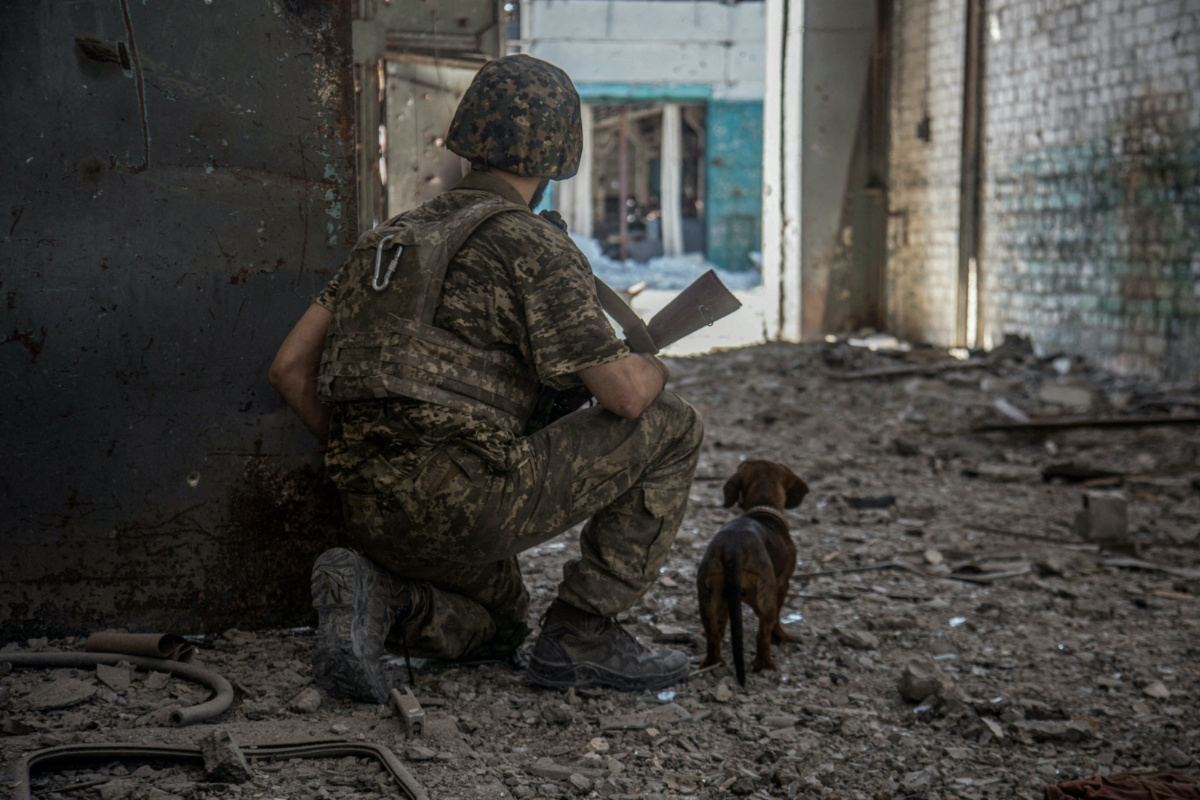
A Ukrainian service member with a dog observes in the industrial area of the city of Sievierodonetsk, as Russia’s attack on Ukraine continues, on 20th June. PICTURE: Reuters/Oleksandr Ratushniak/File photo.
The battle of the Donbas
Having failed to take Kyiv, Russia changed its war aims to focus on securing the Donbas, an eastern region formed of two provinces already partly held by its separatist proxies. That unleashed the most devastating ground battles of the war.
In mid-May, an entire battalion of Russian troops was wiped out trying to cross the Siverskiy Donets River. Satellite photos showed dozens of destroyed armoured vehicles scattered across either bank.
The Russians pressed on, using their artillery firepower advantage to hem in Ukrainian forces on three sides. Throughout June, both sides claimed to have killed thousands of enemy soldiers. After capturing the ruins of the cities of Sievierodonetsk and Lysychansk, Putin declared a victory in the area on 4th July but battles grind on.
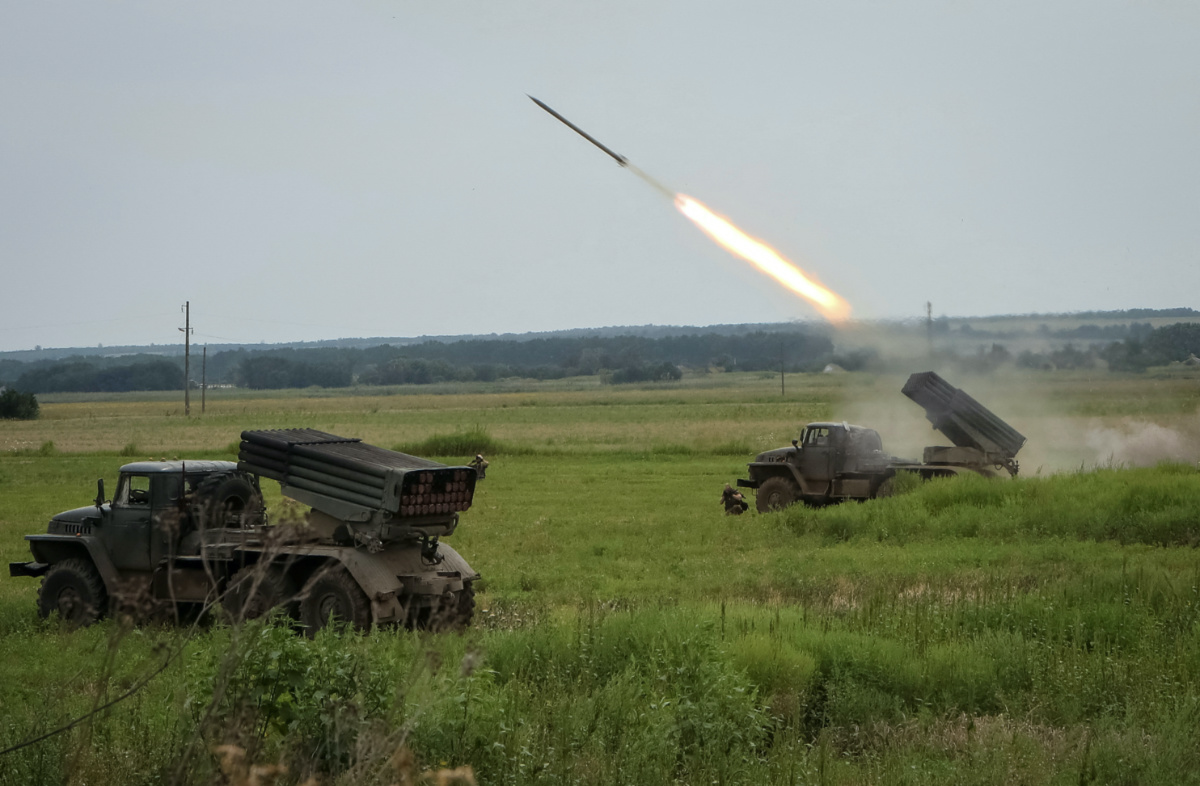
Ukrainian servicemen fire with a BM21 Grad multiple launch rocket system in a frontline in Kharkiv region, as Russia’s attack on Ukraine continues, Ukraine, on 12th August. PICTURE: Reuters/Vyacheslav Madiyevskyy
“HIMARS o’clock”
The war is now focused mainly on the south, where Kyiv has vowed to recapture the biggest swath of territory seized in the invasion that Russia still holds. Russia has rushed in more troops.
Since early July, Ukraine has deployed advanced rockets supplied by the West – the M142 High Mobility Artillery Rocket System, HIMARS. It can now target bridges, railways, command posts and ammunition dumps deep inside Russian-held territory and hopes this will shift the course of the war in its favour.
Ukraine’s supporters on the internet post daily pictures of explosions in Russian-held territory with the catch-phrase “HIMARS O’Clock”. Russia says its operation is going to plan.






